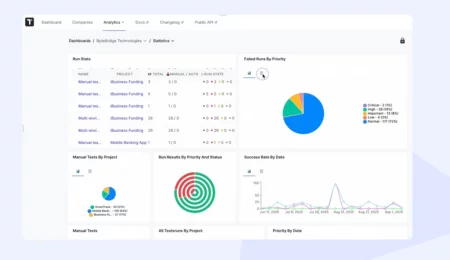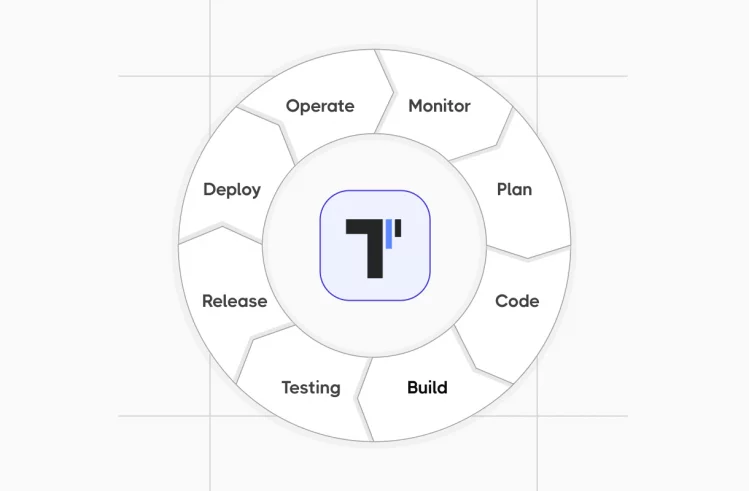In the fast-changing tech world of software development, delivering high-quality software is vital for many businesses. This drives the need of increasing test coverage and effective test suites to provide this.
At the same time, software development accelerates and becomes more iterative and user-centric due to the growth of Agile methodologies and Artificial Intelligence (AI). The test pyramid remains a key tool for effectively organising test automation efforts. Each QA team can adapt this approach to better align with their ongoing Software Development Cycles (SDLC) and Continuous Integration (CI\CD) processes.
Let’s explore the principles of the testing pyramid in today’s dynamic software development landscape in more detail 😃
Understanding the Testing Pyramid Definition
The test pyramid, which many link back to Mike Cohn, is an important idea in software testing to show how to match requirements, along with the different types of tests in a robust software testing strategy.
The testing pyramid suggests using a layered method to distribute testing work across various levels. Following the pyramid, development teams can create a strong test plan that helps them stay balanced and improve efficiency. Namely, it is one such approach to balancing Automated Testing.
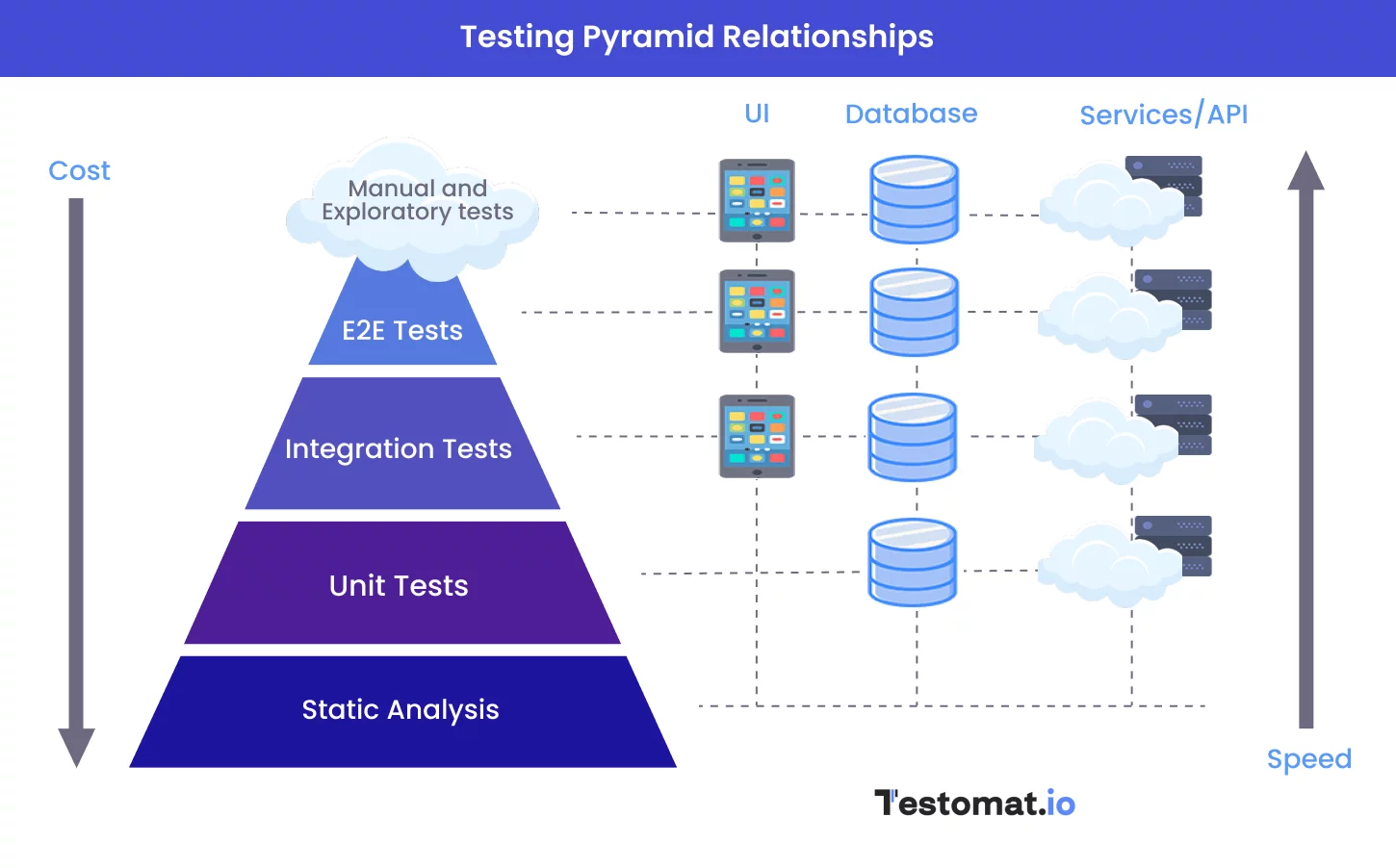
🔴 Pay attention to the arrows in the picture! The pyramid is built to highlight the importance of evaluating testing costs. Testing is generally “cheaper” closer to the base layer.
Setup highlights the need to find bugs early in the development cycle, as test cost is lower and test speed is higher. Similarly, Unit tests focus on smaller components and are easier to write faster tu run and cheaper than E2E and manual testing efforts. This is considered a best practice that gives us the best ratio of time spent in testing and debugging versus the likelihood of finding bugs. By combining different testing levels, like unit tests and UI tests, we can ensure good test coverage. This is also one of the pillars of product quality.
Testing Pyramid Importance in Modern Development
→ Enables a smart approach to automated testing.
→ The pyramid’s structured layers help to utilise resources wisely.
→ It emphasises the necessity for automated testing, particularly at the lower levels.
→ Provides quick feedback, enabling teams to identify and resolve issues early in the process.
→ Prevents bugs from progressing to later development stages, resulting in a reduced need for slow and costly manual testing later on.
The Layers of the Testing Pyramid Explained
At the very beginning, before starting automation, we should conduct minimal statistical analysis at the requirements level to be sure that our application will work exactly as end users expect.
At the bottom are automated tests. It focuses on unit tests. These are the building blocks of a solid testing strategy. They check individual components, by themselves, ensuring each code unit works correctly as expected in isolation.
Next, we go up to integration tests. These tests check how different modules of the software work together. They make sure that all the parts function well when combined, and the data from the API flow successfully between different units or modules without errors.
At the top of the pyramid, we find UI tests. These tests validate how the system works from the user’s point of view. UI tests act like a user touching the screen to see if everything behaves as it should and provides a smooth experience.
According to the testing pyramid, the most tests are on the unit-level, fewer tests on the integration level and the least amount of tests on the system level.
— 🤔 Does that mean that we should write tests for all levels?
— No! We just should select carefully which functionality is tested on which level.
If we can show a problem with a unit test, we use a unit test. Only if a problem cannot be shown with a unit test we go one level upwards by using an integration test or even a system test.
For failing tests we work our way up the testing pyramid. First, all unit-tests need to pass before it makes sense to start debugging either the integration or system tests.
Using this flow, you can debug and fix issues most effectively and efficiently.
Generally, there is a trade-off between speed and confidence, so you can’t skip any level of testing. Gradually, move up; however, you can decide how much focus to place on the different levels. Essentially, it’s about finding the right balance between your time investment and the optimal return in terms of confidence in your software application. That’s what the different shapes of testing signify.
Implementing the Testing Pyramid
Implementing the testing pyramid is a step-by-step process. During this process, it’s important to choose the right tools and technologies. They should help support your automated testing efforts. A strong testing system is very important to ensure your testing is efficient and reliable.
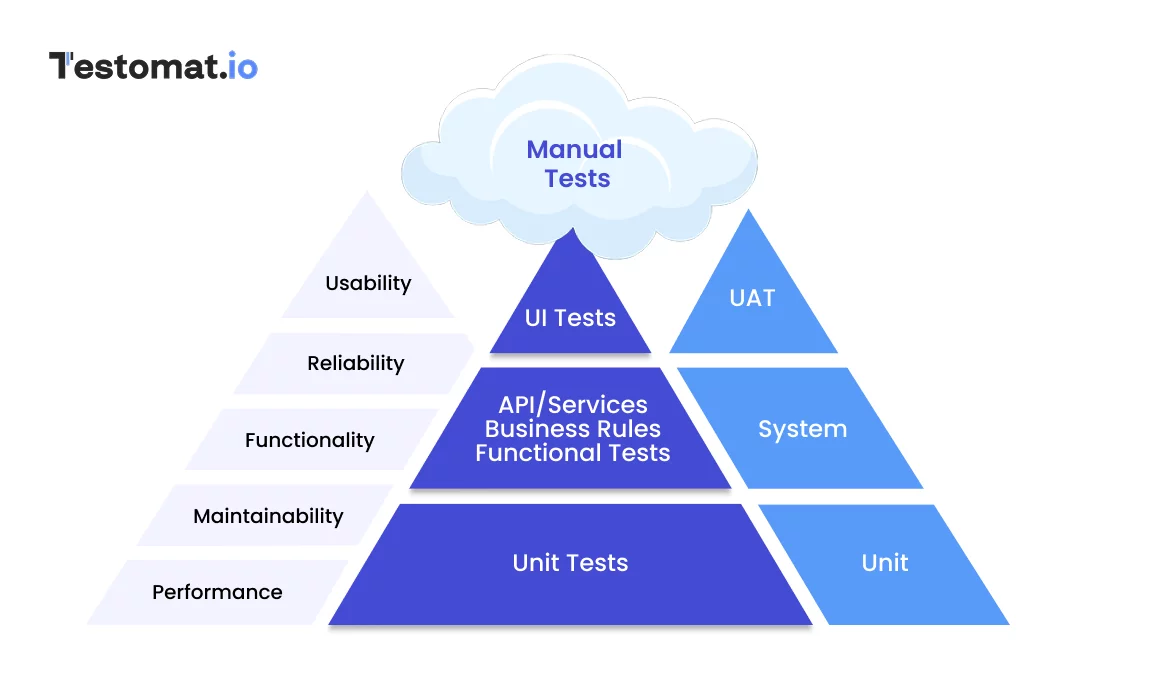
Everything sounds good in theory. But in real life, it is a bit complicated, so let’s go deeper into the testing pyramid levels.
Unit Testing: The Foundation of the Pyramid
Unit testing is the foundation of the testing pyramid. It starts with creating a strong base of unit tests. This process tests the smallest parts of an application, focusing on individual components or modules. Then, we will go higher and combine these pieces, checking how they work together. The goal is to make sure they work as expected. It is important for creating reliable and easy-to-maintain software.
By checking the behavior of these individual units of code, developers can find and fix bugs early in the development cycle. At this stage, issues are easier and cheaper to fix. A good test suite that covers all parts of a unit’s functionality helps developers change code confidently. They will know that any unexpected problems will be found early.
The advantages of strong unit testing go beyond just finding bugs. It also helps create clean code design. Developers are motivated to write modular and loosely connected code, making it simpler to test and maintain. A solid foundation of unit tests is key for any software project. It ensures that developers can make changes and improve the system without worrying about causing new problems.
Integration Testing: The Middle Layer
While unit tests look at single parts, integration tests check how these parts work together and share information. Integration tests are essential for finding problems that happen when separate units join to make bigger modules or when they connect with outside services or databases.
A key part of integration testing is using real test data that mimics how people actually use the system. This approach helps to find issues with data consistency, how well components communicate, and how they manage outside dependencies.
By finding and fixing integration issues early, development teams can avoid expensive repairs later in the software development life cycle (SDLC). At that point, bugs are harder to find and fix, and they can lead to bigger problems.
UI Testing: The Apex of the Pyramid
At the top of the testing pyramid is UI testing. This type of testing looks at how the application behaves and how users experience it. UI tests imitate what users do, like clicking buttons, filling out forms, and moving between different screens. This helps make sure the application works well and gives a smooth user experience.
Setting up UI tests is often more complicated than unit and integration tests because they check everything from start to finish. They need special tools and frameworks that work with the application’s user interface. This makes them more sensitive to changes, which can cause them to break easily.
Even so, UI tests are crucial for checking important steps of user interaction. They help ensure the application meets the expected quality standards. A good UI test suite can address many parts of the user experience, including usability, accessibility, and how well the application works on different browsers and devices.
How Agile Methodologies Influence Testing Approaches
The rise of Agile methods has changed software development and how QA teams test it. Traditional ways, which followed a straight path, have been replaced by iterative and step-by-step methods, and now testing happens all the time during the development cycle. This change highlights the need for early and regular testing during development.
Agile teams know that testing early and often helps find and solve problems fast. They mix testing into the development process from the start. This way, they keep a steady pace in development. Instead of only doing manual testing at the end, Agile teams use automated tests throughout the process. This gives them more confidence when releasing software.
Test automation is key in Agile testing. It plays a very important role in getting fast feedback, managing quick changes and frequent releases.
By automating tests that take a lot of time to run, teams can spend their energy on exploratory testing, usability testing, and other important work that needs human insight and creativity.
In addition, new Agile methods focus on teamwork. This breaks down old barriers and encourages everyone to share the responsibility for quality. Developers, testers, and business people work closely together on all layers of the testing pyramid. Working together like this allows for finding and fixing problems sooner, leading to quicker feedback and better software quality. This teamwork helps everyone stay on the same page about the project’s quality goals, leading to better and more efficient testing efforts.
Shift-Left Testing Strategy within the Testing Pyramid
Shift-Left Testing emphasizes moving testing activities earlier in the software development lifecycle, even before the start of the code stage. When applied to the Testing Pyramid, it focuses on investing more in unit and integration tests — the lower layers of the pyramid — where it is expected.
In Agile settings, the testing pyramid is still an important tool. Anyway, its formulation undergoes.
Evolution of the Testing Pyramid in Agile Environments
The testing pyramid has changed to support Agile ideas. Thus, in addition to the classic testing pyramid, sometimes Unit, Integration, E2E testing are presented in alternative forms like the Trophy, Hexagon, Diamond, and others have also emerged to represent different testing strategies and priorities.
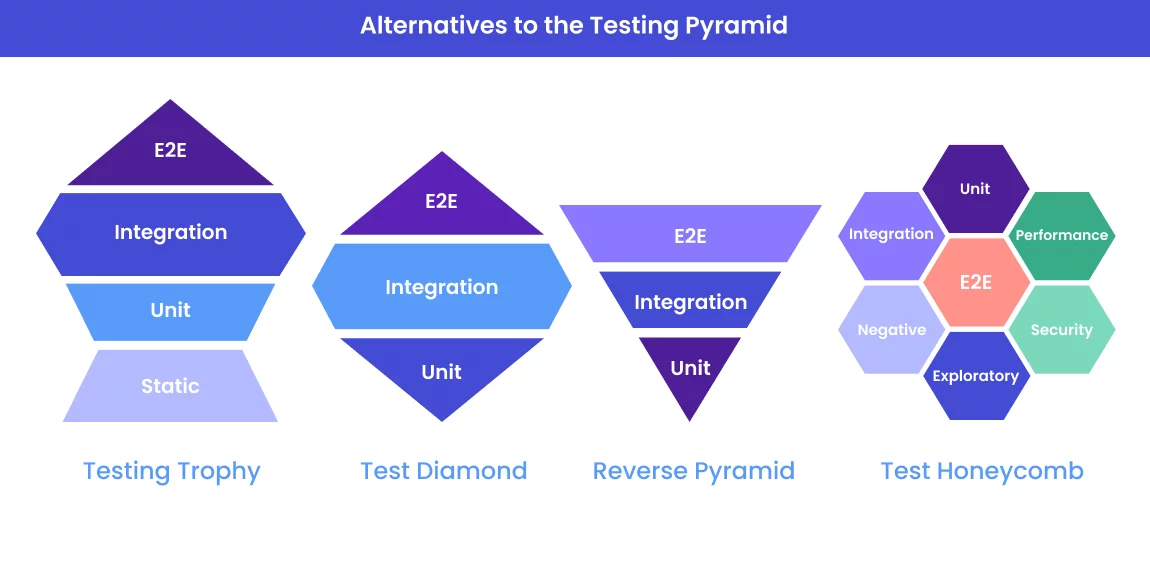
However, it is important to fit these interpretations into the ongoing workflow.
Challenges and Solutions in Applying the Testing Pyramid
The testing pyramid is a helpful guide, but using it can be tough. It is important to know the common mistakes and follow good practices to work through them. You need to balance the different testing levels to get the best test coverage.
To tackle these issues, you must really understand your application and what testing it needs. Your testing strategy should focus on being flexible and improving all the time.
Common Pitfalls and How to Avoid Them
- Using too many UI tests. It is a common mistake. While UI tests are important, having too many can make the testing process weak and slow. Since UI tests are at the top of the pyramid, they should be fewer and more focused than integration or unit tests.
- Ignoring integration testing. This type of testing is important to make sure different parts of the system work well together. If you skip this step, some bugs may not show up until the application is nearly finished. This can lead to expensive corrections.
To avoid these problems, start with a strong group of unit tests as the base of your testing efforts. A balanced testing strategy is essential for good test coverage and for creating high-quality software.
There are challenges to face, like common mistakes, but using the right tools can make testing better.
Tools and Technologies for Effective Automation Testing
The ever-evolving landscape of software development offers a plethora of tools and technologies designed to streamline and enhance the testing process. Leveraging these tools is essential for software developers to maintain the efficiency and effectiveness of their test automation pyramid.
Selecting the appropriate tools depends on various factors, including the programming languages used, the application’s architecture, and the specific testing needs of the project.
| Tools | Description | |
| Unit Testing | JUnit, NUnit, pytest | Frameworks for creating and running unit tests. |
| Integration Testing | REST Assured, Selenium | Tools for testing APIs and interactions between components. |
| UI Testing | Selenium, Cypress, Puppeteer | Frameworks for automating user interface tests by simulating browser interactions. |
| Test Runners | JUnit Runner, TestNG, Mocha | Tools for executing tests, reporting results, and managing test suites. |
| Continuous Integration | Jenkins, Travis CI, CircleCI | Platforms for automating the build, test, and deployment process, enabling continuous integration and delivery (CI/CD) practices. |
Trends Shaping the Testing Landscape
Leading trends are changing software development. They are affecting how we will test and ensure software quality soon.
- The rise of AI and machine learning presents new challenges for testers. Testing AI-powered applications needs special techniques and tools. We need these to check their behavior and make sure they work well.
- More people are using cloud computing. This adds new challenges in the testing process. We must think about things like scalability, reliability, and security in cloud-based environments.
- As development and operations start to blend with DevOps, testing is becoming a key part of the continuous integration and continuous delivery (CI\CD) pipeline.
This means we must shift to automated testing from the earliest stages. It also encourages teamwork between developers, testers, and operations teams. This way, we can ensure fast and smooth software delivery.
The Future of Testing Pyramid Usage
As software development moves forward, the testing pyramid’s future, as we considered on top, will focus on improving test automation. Agile teams need quick feedback, which means an advanced test reporting and analytics dashboard with reach test metrics set on different testing levels, like unit tests and UI tests, we can ensure good test coverage.
In today’s software development, the testing pyramid plays a key role by putting test automation at the base. They should also use manual testing for complicated cases. Agile teams must find a good balance to make the testing process smooth and keep the software quality high.
Adapting the Testing Pyramid for New Technologies
New technologies ask us to change how we test things. As technology becomes a bigger part of software systems, we need our testing strategies to adapt as well.
Changing the testing pyramid for new technologies means we should mix old testing methods with new tools. This helps us handle the special challenges that come with new tech.
If we keep learning about new trends and stay flexible, the testing pyramid can still help us deliver great software, even with all the changes in technology.
Conclusion
In the quick-moving future, keeping up with new AI trends will be key to shaping testing practices. The Testing Pyramid will remain very important in future software development, ensuring speed, flexibility and quality in Agile environments.
